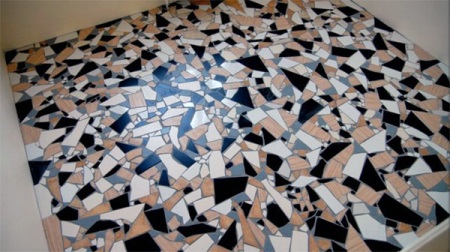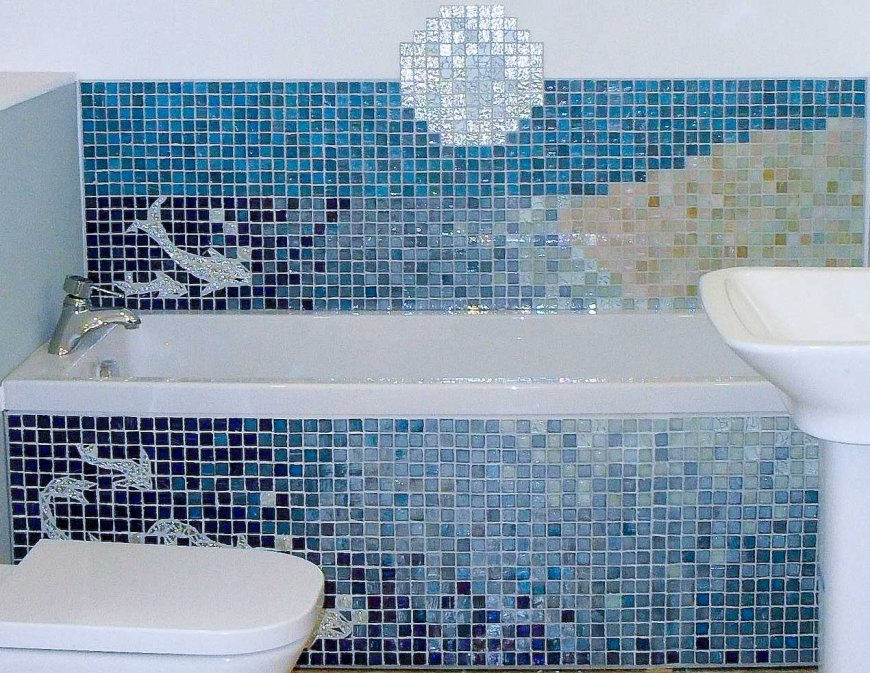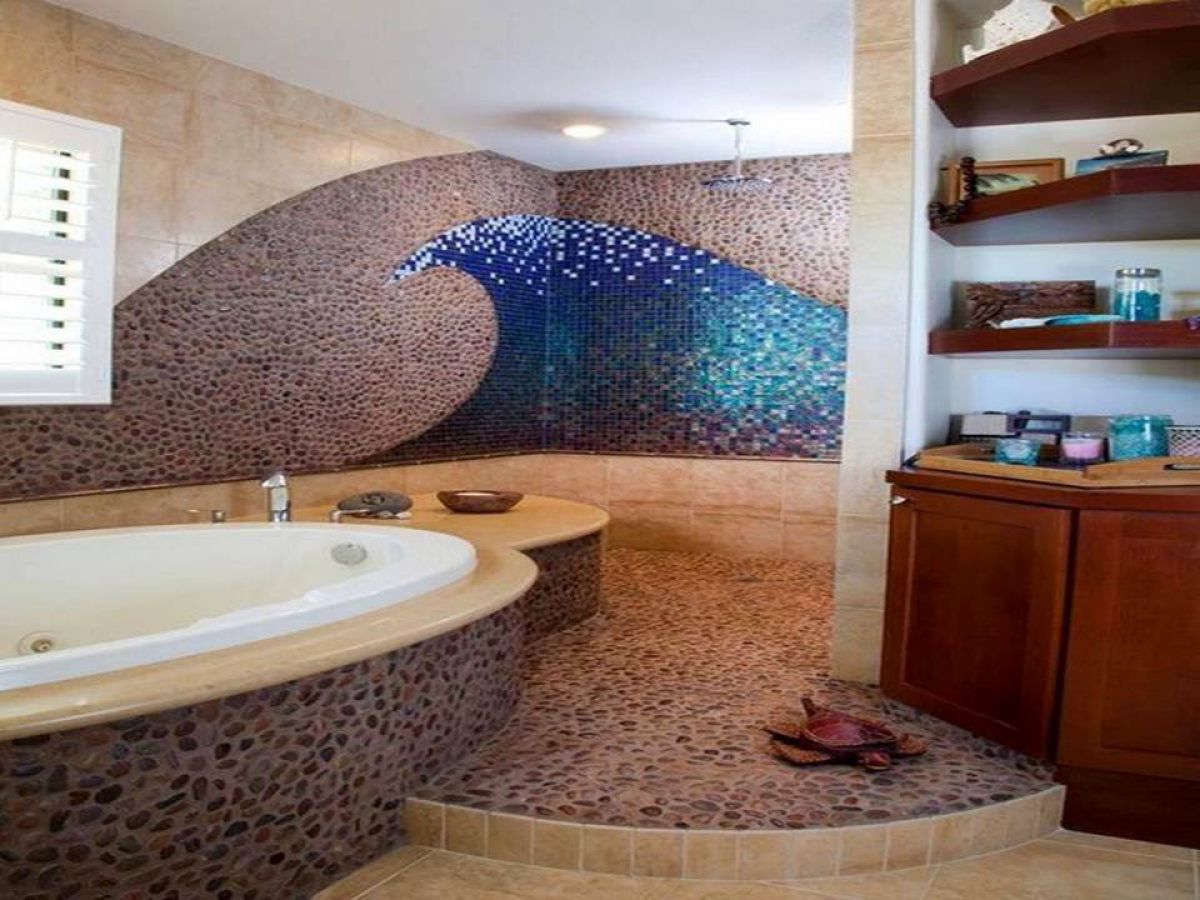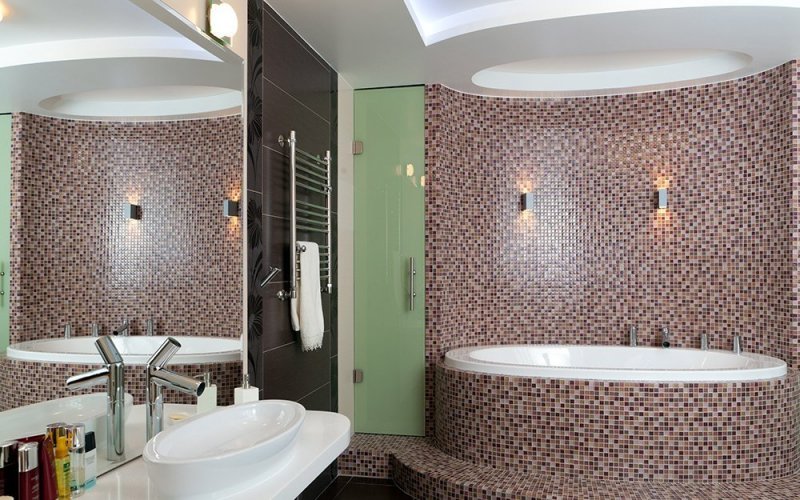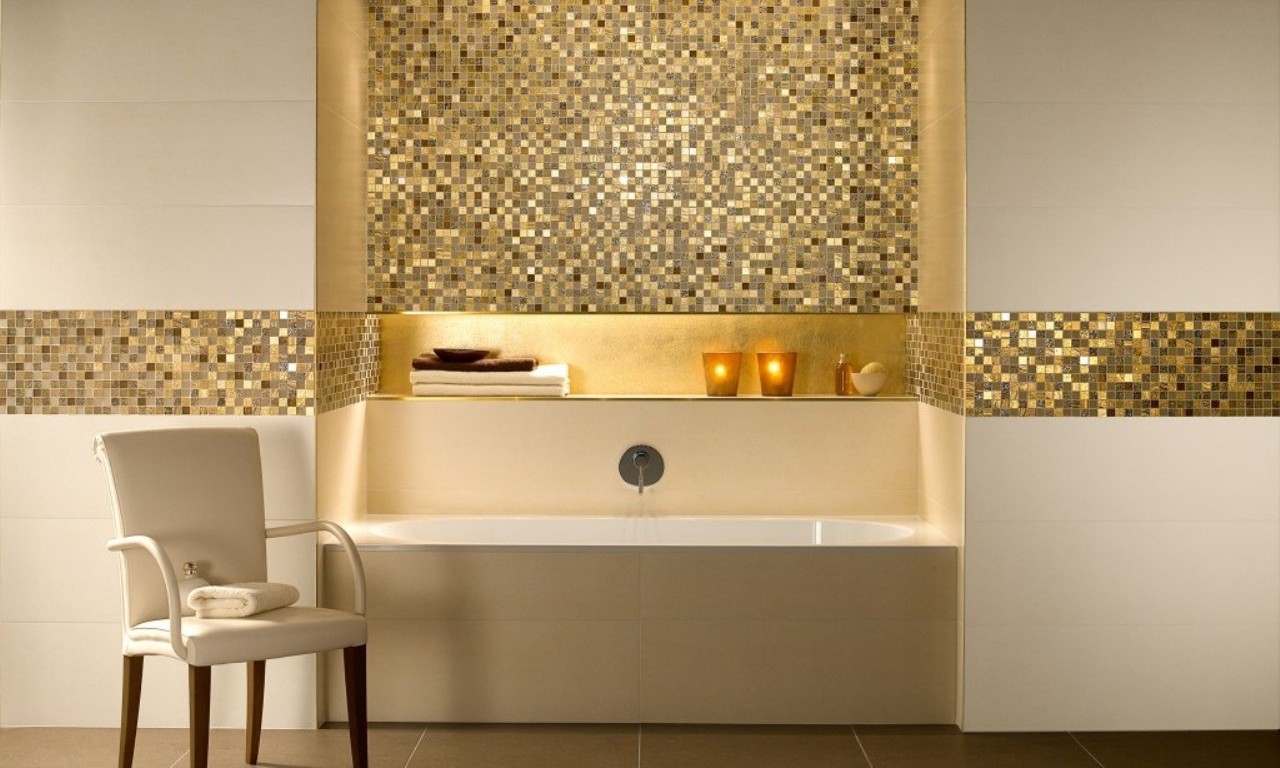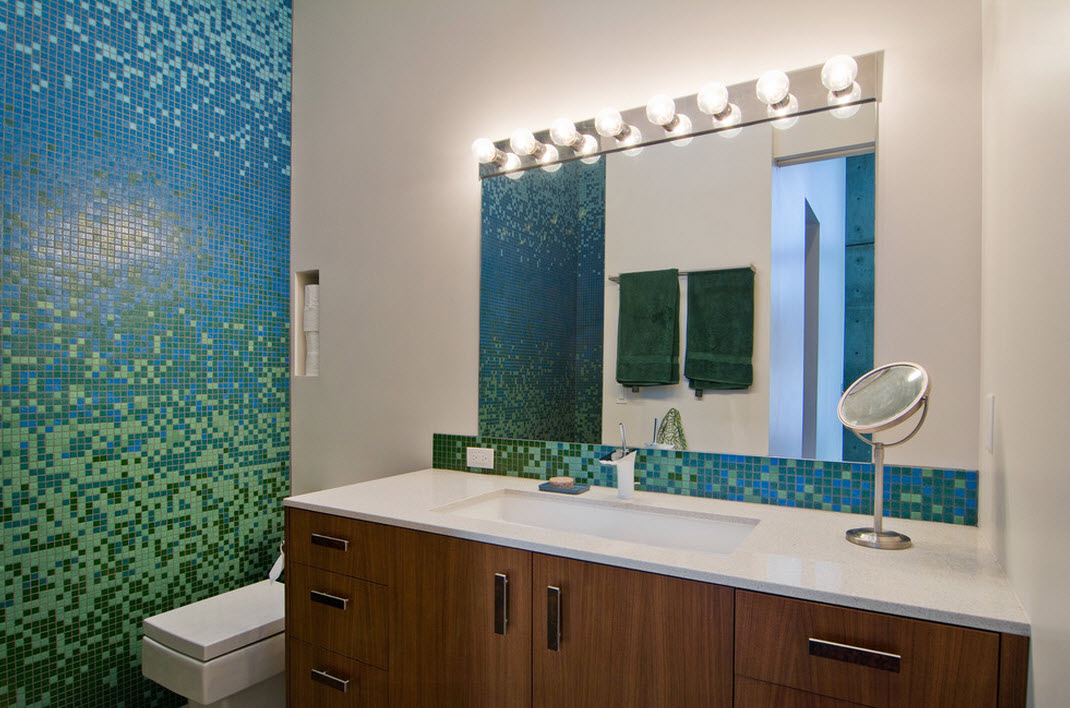All the subtleties of styling on your own
What is required
Even before starting work, in addition to the finishing material itself, you must definitely purchase the following:
- A primer (concrete contact) that will improve the adhesion of the adhesive to the substrate.
- Special dry adhesive composition.
- Grout to match the mosaic or, conversely, in a contrasting color.
Also, those who renovate a bathroom with mosaics need to purchase or borrow the following tools:
- Rubber and notched spatulas.
- Mallet.
- A construction mixer with which the glue will be mixed.
- Nippers or metal tongs used to split mosaic chips.
- A construction knife necessary for cutting a mosaic sheet.
- Pencil.
- Roulette.
- Level.
- Brush or roller for applying the primer.
Carrying out works
Having decided to do everything on your own, you must first learn in detail how to lay a mosaic in the bathroom. Compliance with technological requirements is an important condition for the glued mosaic to remain on the wall for a long time. All work must be done in the following sequence:
- Aligning the walls. If before that you did not have to perform work with plaster mortar, it is worth leveling the walls by fixing cement-bonded particle boards on them. This material is environmentally friendly and durable enough. For its installation, the slabs must be cut to size and fixed on a wooden crate.
- Application of a primer composition to prepared surfaces.
- Bonding of finishing material.
We glue the mosaic
The last step can only be started if the previous layer (primer) is completely dry. In this case, the thickness of the applied adhesive should not be more than 10 mm. It must be evenly distributed over the surface using a spatula. After that, the mosaic tile is pressed against the surface and, if necessary, pressed in with a mallet. Excess mortar is removed with a rubber spatula.
The end result will largely depend on how the first row is laid. You can control its evenness using a level. After laying each row, you need to wait about 20 minutes. During this time, the glue will set. After that, after moistening the protective paper layer, it is necessary to remove it from the surface of the mosaic. Now you can start gluing the next layer.
Removing the protective layer
Styling features
In order for a mosaic bathroom to be decorated very beautifully with your own hands, you need to decide on the option of laying the material. For the floor, you can give preference:
- one-piece coating with a checkerboard pattern;
- narrow frieze;
- a rug in the central part of the room.
Mosaic walls can be laid out:
- panels;
- friezes;
- aprons located near sinks and bathtubs;
- niches and built-in shelves;
- frames and framing.
When choosing the best option, one must proceed from the stylistic features of a particular room, as well as the desired result. A variety of mosaic types and installation methods will definitely allow you to achieve the desired result.
Tiling options and combination cladding
The dimensions of the rooms and its "filling" with plumbing are key parameters when choosing the finishing methods for laying tiles.
It is very crowded in a small Khrushchev, so it is better to install a washing machine under the countertop with a washbasin. It is better to replace a bulky container with a triangular bathtub or jacuzzi. You should not choose large tiles and contrasting styling, this will crush the space.
Dilute the monochromatic solution with rare bright inserts of a small format or patterned tiles.Good lighting, including the perimeter of the ceiling and the mirror frame, will make it a little more spacious.
When choosing materials for finishing, every detail plays an important role.
Walls can be decorated with drawings and patterns
Use decorative tiles, it will perfectly decorate the bathroom
A large bathroom is also considered "problematic" - it is necessary to fill all this space with functional items so that the room does not seem lifeless or empty. Experiments with color, tile shape and type of installation are permissible here:
- classic seam in seam, checked with a plumb line and level;
- staggered (with an offset of the seams, resembles a brick wall);
- diagonally (an original way that expands the space);
- parallel stripes (it is better to do not a solid wall, but fragmentarily);
- modular (stacking fragments of different shapes and sizes, but with a matching edge to get an alternating ornament);
- vertical (rectangular tiles, visually raises ceilings);
- patchwork (variegated tiles with different patterns of the same format, reminiscent of a patchwork quilt);
- mosaic (drawing is laid out from pieces of different shapes and sizes).
If the bathroom is large, you can try experimenting with colors and materials.
In the bathroom, you can hang a picture and put a vase of flowers
You can also experiment with surface area - tiling part of a wall or an entire space, as well as framing functional items or a tank area. A dark bottom and a light top look good, a wide colored strip in the middle or a gradient styling - with a gradual transition from a dark shade of one color to a light one. More interesting ideas are in our photo examples.
Wall-mounted bathtub
Wallpaper is a good alternative to tiles. They perfectly mask uneven walls, are easy to apply and relatively inexpensive. For bathrooms, vinyl or fiberglass wallpapers are used, covered with acrylic lacquer or epoxy paint. Since the bathroom has a high humidity for wallpapering, you should only choose a waterproof adhesive. The wallpaper fits perfectly and blends with the ceramic tiles. The vinyl version has a layered structure: paper on the inside and vinyl on the outside. This coating is resistant to light, so that the wallpaper retains its color and water resistance.
Fiberglass wallpaper
Fiberglass wallpaper is very resistant to mechanical damage. They can successfully hold on the walls for several decades, it is difficult to remove them from the wall. The fiberglass blends into the surface. This wallpaper is for painting.
What to remember when decorating a bathroom with wallpaper?
All wallpaper patterns can be varied using borders that have different widths of colored or patterned stripes. The border also serves as decoration. Although the wallpaper is simple and doesn't require complicated tools, there are some important things to keep in mind to avoid flaking:
- If you decide to use wallpaper, you must remember to choose the right adhesive and base primer. There are many quality glue available on the market today. Each wallpaper manufacturer can offer a specific product that is best suited for wallpapering wallpaper. These materials must be vapor and waterproof.
- Remember the moisture resistance of the wallpaper and the associated hazards. It is advisable to apply wallpaper in a room that has effective rotary or mechanical ventilation so that the material is not exposed to prolonged contact with water. Experts do not recommend wallpaper for small bathrooms, because too much moisture can be released from the wall.
Color combination
Before choosing a mosaic tile option, it is necessary to develop an interior design, its color scheme. If the room is small, the color scheme of the coating and shades must be selected so as to visually expand the space.
- if you want to decorate the bathroom with mosaics using several colors, the color scheme should have muted tones;
- it is desirable that the mosaic version in the bathroom has shades in one color;
- the use of colored mosaics will enliven the smallest bathroom with the play of color and light. This option will allow you to get an effective result of interior design.
If you prefer white, then this decision will not always be correct. It should be supplemented with soft, discreet shades: yellow, pink or cream.
Mosaic tiles in the bathroom
If you want to decorate a room using a mosaic in black or red, a bathroom with a large square is suitable for this solution. Such a mosaic in the bathroom, the photo of which is presented at the bottom of the article, will look good with contrasting grout, a large number of mirrors, a light ceiling and sufficient lighting.
If you use a mosaic with mother-of-pearl tints in the interior, it will perfectly match against a matte background, and a sufficient amount of lighting will give the bathroom additional solemnity.
An extraordinary solution in the design of a bathroom is the use of metal mosaics. Since the color of the metal can add extra coolness to the room, we recommend decorating some areas of the room with metal mosaics. Metal mosaic in the interior of the bathroom, photos and videos are presented on our website.
Very relevant today is the use of a large panel in the bathroom, which combines a huge amount of mosaic colors. Basically, these are all kinds of plants, flowers, leaves. In order for the bathroom not to take on a pompous look, the walls should be decorated with mosaics of the same color, without merging with the variety of panel colors. You can make a lyrical digression by depicting only a part of the flower on the panel.
Mosaic tiles in the bathroom
Mosaic tiles almost always look quite elegant and stylish. But so that the color scheme of the bathroom does not spoil the interior, it is necessary to observe the correct combination of colors and shades:
- if you want the bathroom to resemble the seaside, you need to combine blue and white mosaics;
- so that water procedures in the morning will charge you with vivacity for the whole day, and in the evening you can relax pleasantly, decoration with mosaic in pink color, with the use of gold, will not only fill the bathroom with warmth, but also expand the space;
- orange-purple mosaic will fill the interior of the bathroom with coziness, juiciness, warmth;
- if you apply yellow mosaic interspersed with contrasting and bright colors, the room will acquire a unique look;
- the combination of green and brown will give the bathroom peace;
- apple green mosaic with a steel shade will emphasize a special style;
- charisma and luxury - this is a bright red that can be combined with gold and blue hues.
- the most luxurious color of the mosaic is black. Design options with black color, bathroom tiles - mosaics are presented at the end of the article. If black mosaic tiles are complemented with contrasting white and gold decor elements, this technique can decorate the bathroom. In this case, you should carefully select the combination of mosaics, color, texture, as well as room lighting.
Almost any kind of mosaic tile will brighten up your bathroom. It is not always necessary to obey the advice of designers implicitly. If you invest your bit in the development of design and interior design, the finished version will really delight you. You will be pleased that your imagination and design skills have been embodied in the desired result.
Decorative painting methods
There are several simple ways to decorate walls that are available even to beginners.
Stencils
This is one of the more popular methods. Today, you can find many stencils for painting walls on sale. Disposable appliances are made from vinyl. They have an adhesive backing. Reusable templates are made from durable plastic. There are also acrylic specimens. Such stencils can be tightly fixed on the wall, which greatly simplifies the application of the pattern.

Striped walls
Multi-colored stripes on the walls add a touch of flavor to the interior. The use of this technique helps to visually enlarge the space. To implement this method, you can use different options - it all depends on your imagination. The number and width of the stripes may vary. They also differ in color.
An interesting solution would be stripes of the same color, but different textures. They can be made matte and glossy. To choose the perfect option, it is worth putting the layout of the stripes on the paper, and then color them in. Then you should buy paint and masking tape.
Application rollers
This is one of the simplest and most affordable wall decoration techniques. The special roller can have 2 attachments. Foam absorbs paint, and rubber has an embossed ornament. To use this method, you should first paint the walls in a base color. After that, it is recommended to choose a paint of a contrasting shade and apply it with a special roller to the walls.
Aging effect
This technique is called stippling. First, the plain surface is glazed with a contrasting shade. To do this, use a wide flat brush. Without waiting for drying, touch the surface many times with a coarse brush. This will help you get an unusual texture.
Stardust effect
In this case, specks should be applied to the dried surface using a paint of a different shade. For this purpose, a coarse brush with hard fibers is used. It is recommended to dip it into the paint, squeeze it well and spray it on the wall.
Contrast coloring
To implement this technique, it is worth painting the walls in different colors. Drawings look good - stripes, circles, squares. To get a good result, a sketch of the planned design should be printed on paper.
Chaos of brush strokes
To do this, it is worth making a regular roller, covering it with torn materials. This will help to achieve the appearance of irregular shapes on the walls when applying paint. This is done with a contrasting shade.

Crumpled skin effect
To implement this method, it is worth taking acrylic primer, multi-colored vinyl paint, decorative paper. You will also need a pearlescent glaze. First, the walls should be primed and painted, then attach the paper and crumple it. After that, paint again and remove excess paint from the folds.
Mosaic carpet
Replace the traditional carpet with a mosaic carpet. It is best to lay out the mosaic in the center of the room or near the bath, shower.
Here you can not limit yourself in the choice of colors, not only pastel, but also bright shades are suitable. This design will look effective and stylish.
Shower room
Mosaic can be used to decorate not only the floor near the shower room, but also the shower tray itself. In this case, it will also become strong and durable due to a special cement mortar. Resistant to moisture and lasts a long time.
This method will help to protect the shower process if you choose a mosaic with an anti-slip effect.
Dressing table
Use a mosaic tile to decorate the vanity top. Decorate a beautiful panel without neglecting shades and colors. Unfortunately, making such a tabletop on your own is not so easy, but with a strong desire, everything can work out without problems.
It is better to lay out mosaics of different shapes and sizes.
Styling specifics
Before installing the mosaic, check for defects. Lay out all the elements on the floor, compare their sizes.
Attention! The proportions must be identical, otherwise it will not work to create an even ornament.
Apply glue to the fragments at once. Make markings on the surface of the wall and lay the screed. Then glue is applied to the base. Its layer should not be too large.
If the glue does not have time to harden, the mosaic will move downward.
For cutting, use special iron tongs, wire cutters or a construction knife. After a few days, you need to wipe each seam. During this time, the fragments will reliably grab and will not move.
Surface preparation
The first step is to prepare the wall, level it, otherwise the mosaic will go in "waves". Remember to remove the old trim. The elements "fit" well on wood, plasterboard sheets.
Preparation of surfaces for tiles.
Of the tools, you will need a spatula to apply glue, a knife or tile cutter, nippers to make it the required size.
These are the necessary tools.
Surfaces need to be putty, apply a primer. Fill up cracks, irregularities. Use a building level when leveling the wall.
Making the markup
The markup needs to be done so that the mosaic lies flat. It is applied with a thick pencil or a cord with a weight attached to the ceiling. The line should be straight.
Stages of markup.
Cladding
How to glue mosaics in the bathroom? Laying methods:
- The basic method involves the alternating arrangement of elements on the same line. They are located at a minimum distance.
- When laying chess, they are guided by the basic principle, but they use elements of a contrasting color, alternating them with each other.
- With a linear layout, the ornament is created in even rows. The elements are stacked one after the other.
- Run-up laying implies displacement of the seams relative to the mosaic segment. This method is suitable for round elements and panels.
You need to work especially carefully if self-adhesive finishing mosaic is used for decoration: it is very difficult to peel off the glued elements!
In modular styling, ostentatious negligence is welcomed. Elements that differ in size are placed on a special scheme.
Grouting
You can start grouting the joints one day after laying the mosaic. If you start overwriting them earlier, you can move the fragments.
Grouting is done with a spatula and a rubberized sponge.
Remove the protective self-adhesive membrane (if any), start rubbing the seams first in the horizontal direction and then in the vertical direction. Remove residues with a sponge.
Options for finishing the bathroom with tiles: photo ↑
This is the traditional way of decorating walls and floors in a bathroom. Ceramic tiles have many advantages over other materials:
- withstands temperature differences without changing the geometric dimensions;
- the surface of the tile is not suitable for the spread of mold and the growth of bacteria;
- not afraid of high humidity, since ceramics are practically devoid of pores;
- easy to clean with ordinary household chemicals;
- has excellent aesthetic qualities.
Tiling the bathroom is performed after the installation of all utilities: electrical wiring, water supply, sewerage. The pipes are walled up into the wall or hidden in drywall boxes. Concealed inspection hatches are installed for access to taps and cleaning filters.
Before proceeding with the cladding, you should clean the walls of paint and level the base. Old, crumbling plaster must be disposed of, then treated with a deep penetration primer. If the difference in level is significant (checked by the level), beacons are installed, which are special metal profiles. The plaster mixture should fill the volume limited by the "beacons".
It is better to choose a light tile for small bathrooms: it will visually increase the area of the room.In order for the interior not to seem boring, you should use decorative borders, mosaic inserts.
 Floor ceramics are purchased from the same series as used for wall cladding or matching in color. Its surface should not be slippery
Floor ceramics are purchased from the same series as used for wall cladding or matching in color. Its surface should not be slippery
Porcelain stoneware is becoming more and more popular: facing with such a material is made in the same way as when using tiles, but the surface resembles natural stone.
They cut the tiles with a special tool - a tile cutter or a grinder with a diamond wheel. For lighter clays, you can use a regular glass cutter. The holes are made with carbide-tipped drills, crowns or ballerinas.
 They cut ceramic tiles with a grinder with a diamond wheel
They cut ceramic tiles with a grinder with a diamond wheel
The cladding can start from the corner or from the middle of the wall: it all depends on how many whole tiles fit in one row. Everything should be calculated correctly to avoid the use of narrow "trims" around the edges. At the end, it is necessary to seal the joints between the tiles with a moisture-resistant grout of a suitable color.
 Facing with porcelain stoneware
Facing with porcelain stoneware
The ceiling is best made of seamless plastic. It is better to buy expensive - it does not turn yellow over time and has greater strength. Plastic panels are attached to the battens made of wooden beams or metal profiles. A good option would be a PVC film stretch ceiling.
Recessed lamps are used to illuminate the room. The finishing of the bathroom is completed by attaching mirrors, towel holders, hooks.
 Dark ceramic tiles are only suitable for large rooms
Dark ceramic tiles are only suitable for large rooms
Advantages of using mosaic in the bathroom interior
Mosaic is a way to create a floor or wall image by collecting and fixing pieces of stone, glass, metal, ceramics on the surface. Facing mosaic is a tile (chip), the size of which has been reduced tenfold. The standard chip size is 2 to 5 centimeters. The decoration of the premises with mosaic chips dates back to the 4th millennium BC. Mosaic was an element of decorative and visual art, unique examples of which have survived to this day.
> The release of mosaic blocks (flexible composable sheets) with a size of 30x30 centimeters simplifies installation and allows them to find wide application in design. With the help of mosaics, you can make a unique cladding of walls, floors, plumbing. It can be a monochrome coating, with the image of the original ornament on the entire area, or in part or in the form of artistic paintings.
Finishing depends on the design idea and taste preferences and is acceptable in any style:
- classic;
- modernist;
- bionics.
Mosaic has an advantage over traditional bathroom tiled cladding not only in the possibilities of decoration. It surpasses the tile in terms of performance, which are expressed:
- in resistance to high humidity;
- temperature difference;
- mechanical stress.

An important advantage of mosaics is the possibility of high-quality finishing of corners, niches, ledges. Waste during the installation of a mosaic coating does not exceed 5%, which is lower than when working with tiles. In general, mosaic is an effective, reliable, durable coating. The disadvantages of mosaics include higher cost and experience requirements for cladding.
How Mosaic Can Be Used
It is undesirable to decorate all surfaces with mosaic tiles in the bathroom - this will make the mosaic decoration pretentious, deprive it of comfort. Consider also that mosaic is not a cheap material. Such a tile is best used to decorate one wall.
A drawing or a mosaic panel will bring a colorful accent to the interior, contributing to the visual expansion of spatial boundaries.
Sink working area
The classic idea is to decorate the work area with inexpensive mosaic tiles - they can be glued next to the sink.If you put self-adhesive tiles, this will solve several problems at once.
It will make it easier to keep the work area, any niches, shelves and ledges clean. Drops of water, gels, shampoos often fall on it. Such marks are difficult to remove from other finishing materials.
It is easy to remove the foam from the mosaic cladding, there will be no stains and ugly stains on the surfaces.
Combining mosaics and tiles in the bathroom is also a good way. Use a mosaic of a different color or size to decorate the area next to the mirror or the opposite wall. Thanks to the reflection, the number of shades will increase - this will make the interior really bright and original.
Emphasis on the vertical
Focus on a vertical surface, such as a free wall or the one opposite a window opening. Drawings should not be overly variegated and conspicuous, as the bathroom is designed to give a sense of tranquility.
I do not advise decorating the wall behind the font or shower stall with mosaic tiles, it will be invisible there.
The panel greatly adorns the design of the bathroom.
The most reasonable color solution is to decorate the wall opposite the bathroom with a mosaic panel.
While enjoying your stay in warm water, you will be able to contemplate beautiful ornaments.
Flooring
Decorating the bathroom floor with mosaics is an original idea. Carpets have not been laid here for a long time: they quickly get dirty, poorly absorb water.
Using mosaic tiles on the bathroom floor, you can create an imitation of a carpet, decorate the surface with bright patterns.
It will be pleasant to step on such a surface even without shoes. Mosaics decorate the entire surface using muted shades or individual areas: for example, the area bordering a bathtub or sink like a rubber mat.
Finishing of individual parts
When decorating the walls with mosaics, I advise you to place the elements vertically - visually this will increase the space, the room will seem more spacious, and the ceiling will be higher.
There are many variations of mosaic decoration:
- A great idea is to create an imitation of a waterfall on the wall above the bathroom. The illusion of water falling from above will appear. You can lay out from a mosaic of beautiful birds, mountain peaks.
- If your home has a shower room, create an imitation of water flowing out of the shower. Waterfalls are created in a similar way.
- But most often they imitate raindrops on surfaces. Under the influence of moisture, they acquire a shine and make the room cozy.
A beautiful mosaic panel with a dolphin - it's time to splash!
The bath itself can be decorated with mosaic tiles in an original way, but provided that it is light, an interior highlight will appear.
Complex rooms
Bathrooms are not always of a standard configuration and size. If the layout is normal, there are no problems with the design, but another situation is possible. In homes located in the private sector, bathrooms are often located in the attic, which has a non-standard size.
Spacious rooms can be decorated in any color.
It is much more difficult to decorate walls with asymmetry.
Mosaic tiles for rooms with complex and intricate geometry are a good choice. At the stage of decorating the walls, you will not have to cut the tile, its overrun will be minimized.
Concave and convex surfaces can be decorated with mosaics.
Plastic
Plastic walls - the material is absolutely safe for human health
When choosing, you should pay attention to the variety.
The best option is laminate panels, since it is resistant to various types of external damage due to a strong surface film. Thanks to the protective coating, it also does not fade, the pattern is not distorted, and the color saturation is preserved.
Main advantages:
- The ability to mount on any wall surface: plaster, putty, and so on.
- Large, varied selection.
- Ease of cleaning from contamination.
- Possibility of simple repair, panel reinstallation.
Bathroom wall paint
Paints intended for wet rooms, in their composition, have special formulas that protect the painted surface from moisture penetration and the development of various types of mold and fungi. Most often these are silver ions. They are available in a very wide range of colors, so you can match the color perfectly to your interior or furniture. Suitable properties, low cost and ease of application to the wall make the paint a unique solution.
Painting the bathroom instead of tiles? Smart solution, as bathroom paint protects the walls of the room from moisture and provides lasting colors. Bathroom without tiles is an increasingly popular solution. You can decorate surfaces with stickers, wall paintings, or even panels.
Tips & Tricks
Modern bathroom trends recommend minimal use of tiles, that is, only in a damp area. Is a bathroom practical without tiles? How to decorate the walls in the bathroom? You can paint the room, but be sure to choose special substances that are resistant to moisture. It is worth deciding on such a decision when we do not have a shower cabin, when you want to create a special room design, for example, a Provencal, romantic bathroom in a rustic style, or there is simply no desire to invest heavily in plumbing.
How to protect bathroom walls from moisture when painting?
To paint the bathroom, use special paints that keep moisture out and allow the wall to breathe. If the room is large, move the tub away from the wall as this will protect the plaster from splashing. If the plumbing needs to stand next to a wall, you can use a large format mural or attach a mirror surface to the tile. This bathroom wall decoration gives the interior the style and pleasant warmth that you always like. A bathroom without tiles will take on an interesting and cozy character, and the color of the walls in the room will undoubtedly be easier to change next season than investing in new tiles.
Mosaic types
This category of cladding is classified not only by the type of material of manufacture, but also by the type of base.
| Variety of base | Description |
| 1. Grid. | A certain number of elements are superimposed on the base in the desired order. As a result, square-shaped samples are obtained, which are attached to the wall in the form of a square, rectangle. With such squares it is easy and quick to arrange bulges, corners, niches, protrusions of any area, etc. This is due to the flexibility and ductility of the mesh. |
| 2. Paper. | On the tiles laid out in the desired order, paper is glued on top of the front side. It helps to maintain the desired order and uniformity. After all the components are laid, the glue is dry, you need to moisten the paper with warm water, and carefully remove. |
| 3. Without reason. | Small particles are laid out directly on the wall surface. This type of masonry is performed only by highly qualified finishers. |
There is one more gradation depending on the shape: square, rectangle, oval, broken lines, etc.

Glass
Glass mosaic is used not only in the interior of the bathroom, but also in other premises. It is considered one of the oldest materials. Previously, it was practically inaccessible due to the high cost.
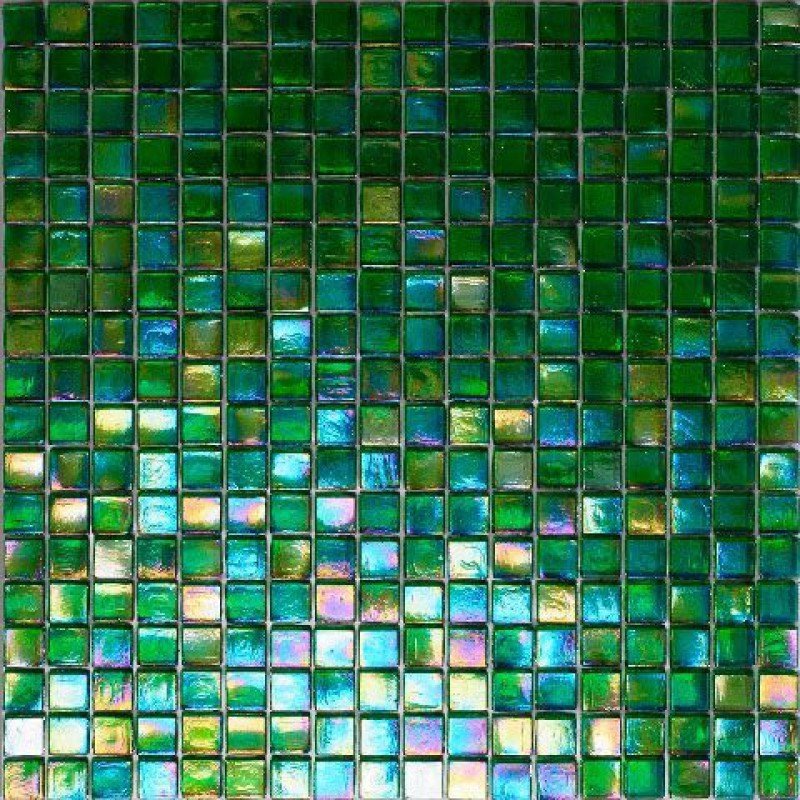
According to external data and composition, the tile practically corresponds to ordinary glass. The difference lies in the increased strength. All ingredients are combined by heating to enormous temperatures - 1500 C. Then the molten mass is distributed in special forms. A high degree of strength is ensured by a unique high temperature firing technology and a small size.

For a wide variety of colors, metal oxides are mixed into the composition.

Scope of application
Small glass tiles are actively used for decorating bathrooms or kitchens.This material is used to decorate walls in saunas, swimming pools, fountains.
Advantages:
- a wide selection of glass cladding in various colors thanks to the natural coloring agents in the composition. Among the glass varieties you can find colorless models, bright or dark colors, gloss, and many others;
- resistance to the reproduction of microbes, fungi and mold spores;
- high strength of the tile;
- resistance to moisture and temperature changes. Easily tolerates persistent frosts and high temperatures;
- versatility. Can be used for both walls and floors;
- low cost.
Ceramics
The most widely used option. It is analogous to standard reduced-size ceramic tiles. The surface can be smooth, rough, have abrasions, inserts of other colors. There are different shapes, squares are most in demand.
Advantages:
- does not require special care;
- resistant to cleaning agents;
- strength and durability;
- resistance to moisture and temperature changes;
- a wide variety of color options gives a chance to implement non-standard design ideas.

Smalt
This type of product is made by pressing multi-colored glass and dyes. There are exotic colors - gold, turquoise, blue, or classic - white, black, yellow, gray, beige, etc. The resulting mass is “fried” at high temperatures.

Advantages:
- does not lose its properties under the influence of highly toxic chemicals;
- easily tolerates high humidity and temperature changes;
- unusually beautiful, bright color palette;
- variety of forms;
- produced in the form of small elements, whole large pieces.

Minuses:
high price. It is explained by the complexity and high cost of the production process.
With the help of this variety, designers reproduce modern exclusive panels. For this, solid sheets are divided into pieces of the desired size using a special tool. Only professionals can do this kind of work.

A natural stone
We can say that this is a budget option, with the exception of marble.

It is made from different types of stones. As a result of various forms and types of processing, elements of incredible, irregular shapes are obtained. The stone can be polished, polished, cut.
Advantages:
- wear resistance;
- strength, durability;
- resistance to household chemicals;
- resistance to temperature changes.

Scope of application
Stone mosaic panels have found their application on the paths of personal plots, in the decoration of the walls of bathrooms, window sills, kitchen aprons and many other elements. Unusualness lies in natural naturalness, a variety of shapes, colors and shades.

DIY mosaic
Decorating a bathroom with mosaic is quite an expensive pleasure and not everyone can afford it. But, there is a way out! You can make it yourself from broken ceramic tiles. This will allow you to decorate the room and save a lot. Such a mosaic is laid out strictly according to the sketch. First you need to clearly imagine what kind of result you want to get. Then put this on paper and then select the appropriate tiles. To avoid unnecessary splinters when splitting tiles, wrap the tiles with a cloth and smash them with a hammer. A ceramic tile mosaic is laid out at intervals.

Use tile adhesive to keep the elements firmly in place. It is applied to the base in a thin layer. The gaps between the fragments are treated with a solution when the glue dries well. The grout can then be applied using a rubber trowel. The resulting seams are treated with trowel varnish.
